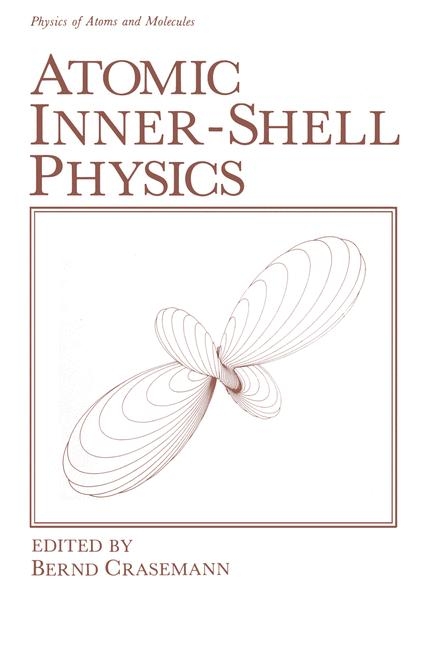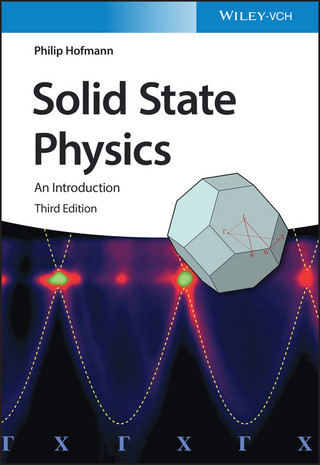
Atomic Inner-Shell Physics
Kluwer Academic/Plenum Publishers (Verlag)
978-0-306-41847-1 (ISBN)
- Titel ist leider vergriffen;
keine Neuauflage - Artikel merken
A: Atomic Structure and Transitions.- 1 Relativistic and Quantum Electrodynamic Effects on Atomic Inner Shells.- 1. Introduction.- 2. Review of the Dirac-Fock Method.- 3. Breit Interaction.- 4. Quantum Electrodynamic Corrections.- 5. Conclusion.- References.- 2 Relativistic Calculation of Atomic Transition Probabilities.- 1. Introduction.- 2. The Relativistic Theory of Many-Electron Atoms.- 2.1. Relativistic Hamiltonian from Quantum Electrodynamics.- 2.2. Interpretation of the Dirac-Fock Approach.- 3. Relativistic Transition Energies.- 3.1. Atomic Binding Energies and X-Ray Transition Energies.- 3.2. Auger Energies.- 4. Radiative Transitions.- 4.1. Introduction.- 4.2. Formulation of Relativistic Radiative Transitions.- 4.3. Effects of Relativity, Retardation, and Higher Multipoles.- 4.4. Exchange and Overlap Corrections.- 4.5. K X-Ray Hypersatellites.- 5. Radiationless Transitions.- 5.1. Introduction.- 5.2. Relativistic Theory of Auger Transitions.- 5.3. Effects of Relativity on Auger Transitions.- 5.4. Analysis of K-LL and K-MM Auger Spectra.- 6. Auger and Fluorescence Yields of Multiply Ionized Atoms.- 6.1. Fluorescence Yields of Atoms with Multiple Vacancies.- 6.2. Effects of Relativity on the Decay of Few-Electron Ions.- 7. Summary.- References.- 3 Many-Body Effects in Energetic Atomic Transitions.- 1. Introduction.- 2. Higher-Energy Processes: Transitions from Inner Shells.- 2.1. Introduction.- 2.2. Binding Energy.- 2.3. Intensity.- 2.4. Satellites.- 3. Low-Energy Processes: Transitions from Subvalence Subshells.- 3.1. Weak Inner-Shell Transitions in the Presence of Strong Outer-Shell Transitions.- 3.2. Strong Inner-Shell Transitions with Weak Outer-Shell Transitions.- 4. Concluding Remarks.- References.- 4 Auger-Electron Spectrometry of Core Levels of Atoms.- 1. Introduction.- 2. Theory of Auger Transitions and Basic Considerations.- 2.1. Definitions and Notation.- 2.2. Theory of Auger Transitions; the Wentzel Ansatz.- 2.3. The Auger Effect Treated beyond the Wentzel Ansatz.- 3. Experimental Arrangements.- 4. Diagram Auger Transitions.- 4.1. Energies.- 4.2. Intensities.- 4.3. Linewidths.- 5. Auger Satellite Transitions Due to Many-Electron Effects.- 5.1. Satellite Transitions Due to Final-Ionic-State Configuration Interaction (FISCI).- 5.2. Satellite Transitions Due to Initial-State Configuration Interaction (ISCI)..- 6. Auger Spectra of Multiply Ionized Atoms.- 6.1. The (1s2p)-1 Auger Spectrum of Ne.- 6.2. Auger Spectra of Li-like Target Ions.- 7. Projectile Auger-Electron Spectrometry.- 8. Anisotropic Angular Distribution of Auger Electrons.- 8.1. Particle-Impact Experiments with Axial Symmetry.- 8.2. Photon-Impact Experiments with Axial Symmetry.- 8.3. Experiments with Plane Symmetry.- 9. Postcollision Interaction Effects in Auger Spectra.- References.- 5 Experimental Evaluation of Inner-Vacancy Level Energies for Comparison with Theory.- 1. Introduction and Overview.- 2. Methods for Determining Levels and Level Differences.- 2.1. Absorption Spectroscopy.- 2.2. Photoelectron and Auger-Electron Spectroscopies.- 2.3. Appearance-Potential Spectroscopy.- 2.4. X-Ray Emission Spectroscopy.- 3. Experimental Techniques for High-Accuracy Spectroscopy.- 3.1. Wavelength Determination in the Grating Region.- 3.2. Wavelength Problems in Crystal-Diffraction Spectroscopy.- 3.3. Local Scales and Conversion Factors.- 3.4. Wavelengths Based on X-Ray Interferometry.- 3.5. Wavelength Measurements with Focusing Instruments.- 4. Selected Experimental Results.- 4.1. Measurements from Direct-Reading Instruments.- 4.2. Measurements Referred to Directly Measured y-Ray Lines.- 4.3. Measurements Referred to Directly Measured X-Ray Lines.- 4.4. One-Electron and Few-Electron Spectra.- 5. Theoretical Calculations and Comparison with Experiment.- 5.1. Relativistic Self-Consistent-Field Calculations.- 5.2. Theoretical Relativistic SCF Estimates.- 5.3. Comparison with Experiment.- 5.4. Conclusions Derived from Comparison.- 6. Summary and Outlook.- 6.1. Relation between Single-Electron and X-Ray Spectra.- 6.2. Future Measurements and Applications.- References.- 6 Mechanisms for Energy Shifts of Atomic K X Rays.- 1. Introduction.- 2. The Experimental Method.- 3. The Isotope Shift.- 4. The Chemical Shift.- 4.1. Origin of the Chemical Shift.- 4.2. Examples of Data and Applications.- 5. The 1s Hyperfine Shift.- 5.1. Population of the Hyperfine-Structure Components in EC Beta Decay and Internal Conversion (IC).- 5.2. Experimental Observations of 1s Hyperfine Shifts.- 6. The Dynamic Shift.- 6.1. Outer-Shell Shake-Off and Its Effects on K X-Ray Energies.- 6.2. Experimental Detection of the Dynamic Shift.- 7. The Atomic Structure Shift for Transitions with ?Z= 1.- 7.1. The 6s Elements.- 7.2. The 4f Elements.- 7.3. The 4d Elements.- 7.4. The 5d Elements.- 8. Other Contributions.- 8.1. Deviations from the Breit-Wigner Single-Level Line Shape.- 8.2. The Coupling of Atomic and Nuclear Excitations.- 9. Concluding Remarks.- References.- 7 Atomic Physics Research with Synchrotron Radiation.- 1. Introduction.- 2. Synchrotron Radiation.- 3. Techniques.- 4. Many-Electron Effects.- 5. Excitation/Deexcitation Dynamics.- 6. Photoionization of Atoms in Excited States.- 7. Molecular Physics.- 8. Conclusion.- References.- 8 Investigations of Inner-Shell States by the Electron Energy-Loss Technique at High Resolution.- 1. Introduction.- 1.1. Early Inner-Shell Excitation Studies.- 1.2. High-Resolution Studies.- 1.3. Comparison of the Photoabsorption and Electron Energy-Loss Techniques.- 2. Experimental Details.- 2.1. Electron Source and Energy Selector.- 2.2. Energy Analyzer and Detection System.- 2.3. Energy Calibration.- 2.4. Multidetection Techniques.- 3. High-Resolution Studies of Atoms.- 3.1. Analysis of Energy-Loss Spectra.- 3.2. Argon.- 3.3. Krypton.- 3.4. Xenon.- 3.5. Equivalent-Core Model.- 4. High-Resolution Studies of Molecules.- 4.1. Nitrogen.- 4.2. Carbon Monoxide.- 4.3. The Application of the Equivalent-Core Model to Chlorine.- 4.4. Polyatomic Molecules.- 5. The Observation of Electric-Dipole-Forbidden Inner-Shell Transitions.- 5.1. Experimental Details.- 5.2. Electric-Dipole-Forbidden Inner-Shell Transitions in Atoms.- 5.3. Electric-Dipole-Forbidden Inner-Shell Transitions in N2.- 5.4. Electric-Dipole-Forbidden Inner-Shell Transitions in Other Molecules.- 6. Inner-Shell Resonances.- 6.1. Experimental Details.- 6.2. Inner-Shell Resonance in N2.- 6.3. Inner-Shell Resonance in Other Molecules.- References.- 9 Coherence Effects in Electron Emission By Atoms.- 1. General Introduction.- 2. Interference of Contributions from Different Magnetic Substates—Angular Electron Intensity Distribution.- 2.1. Introduction.- 2.2. Theory.- 2.3. Comparison with Experimental Results for Autoionization of He**(2p2) 1D.- 3. Interference of Contributions from Different States in One Atom.- 3.1. Introduction.- 3.2. Theory.- 3.3. Comparison with Experimental Results for Collisions of Li+ with He.- 4. Interference of Contributions from Direct and Indirect Processes.- 4.1. Introduction.- 4.2. Theory.- 4.3. Comparison with Experimental Results for the Process ?- + He ? He*(1snl) + ?-.- 5. Interference of Contributions from Different Distances on One Potential Curve.- 5.1. Introduction.- 5.2. Theory.- 5.3. Comparison with Experimental Data for Inner-Shell Electron-Impact Ionization of Ar L Followed by Auger Decay.- 6. Interference of Contributions from Different Atoms.- 6.1. Introduction.- 6.2. Theory.- 6.3. Comparison with Experimental Data.- References.- B: Scattering and Collision-Induced Processes.- 10 Inelastic X-Ray Scattering Including Resonance Phenomena.- 1. Introduction.- 2. Theory.- 2.1. Resonant Scattering Involving Photons and Electrons.- 2.2. Statistical Formulation of Inelastic Scattering.- 2.3. Nonrelativistic Cross Section.- 3. Nonresonant Scattering.- 4. Resonant Scattering.- 4.1. Evolution of Resonant Scattering into Fluorescence.- 4.2. Total Cross Section.- 4.3. Infrared Divergence.- 5. Relativistic Amplitude for Inelastic Scattering and Gauge Invariance.- 5.1. Relativistic Formulation.- 5.2. Gauge Invariance.- 5.3. Length versus Velocity Forms.- 6. Angular Distribution and Polarization.- 6.1. General Formalism for Inelastic Photon Scattering.- 6.2. Scattering Patterns in Dipole Approximation.- References.- 11 Rayleigh Scattering: Elastic Photon Scattering by Bound Electrons.- 1. Introduction.- 2. Physical Features of Elastic Scattering.- 2.1. The Blue Sky of John William Strutt.- 2.2. “Elastic” versus “Coherent” Scattering.- 2.3. Scattering by Free Electrons: Thomson and Compton Scattering.- 2.4. Photon Polarization Effects.- 2.5. Classical Scattering by a Bound Charge.- 2.6. An Independent-Electron Atomic Model.- 2.7. High-Energy Scattering and the Form-Factor Approximation.- 2.8. Scattering from a Compound System.- 3. Development of Theory.- 3.1. The Rayleigh Scattering Amplitude.- 3.2. Simple Atomic Scattering-Factor Theories.- 3.3. Total-Atom Elastic Scattering Amplitudes.- 4. Development of Experiment.- 4.1. Direct Measurements of d?/d?.- 4.2. The Anomalous Scattering Factors.- 5. A Comparison of Theory and Experiment.- 5.1. Differential Scattering of Low-Energy Gamma Rays.- 5.2. Small-Angle Scattering.- 6. Rayleigh-Scattering Applications.- 6.1. Solid-State Structure Studies.- 6.2. Nuclear Structure Studies.- 6.3. Observation of Delbrück Scattering.- 6.4. X-Ray Diagnostics.- 6.5. Narrow-Beam Attenuation.- 7. Further Research Topics.- References.- 12 Electron-Atom Bremsstrahlung.- 1. Introduction.- 2. Observables and Assumptions.- 3. History.- 4. Characteristic Distances and Appropriate Formulations.- 5. The Coulomb Spectrum.- 6. Screening.- 7. End Points of the Spectrum.- 8. Angular Distributions and Polarization Correlations.- 9. Comparison of Theory and Experiment.- 10. Some New Developments.- References.- 13 X-Ray and Bremsstrahlung Production in Nuclear Reactions.- 1. Introduction.- 2. Theory of Interference Experiments.- 2.1. Basic Idea.- 2.2. Survey of Atomic Collision Processes.- 2.3. Quantum-Mechanical Theory.- 2.4. Discussion.- 3. Interference Experiments.- 3.1. K-Shell Ionization in Elastic Proton Scattering Reactions.- 3.2. Bremsstrahlung Emission near Elastic Proton Resonances.- 3.3. Ionized Electron Measurements.- 3.4. Isobaric Analog Resonances.- 3.5. K-Shell Ionization by Neutrons.- 3.6. Cross-Section Measurements.- 3.7. K-Shell Ionization in Inelastic Nuclear Reactions.- 4. United-Atom X Rays.- 4.1. Theory.- 4.2. Experiments.- 4.3. Widths of United-Atom K X-Ray Lines.- 5. Conclusion.- References.- 14 Positron Production in Heavy-Ion Collisions.- 1. Introduction.- 2. Electron-Positron Excitations in Superheavy Quasimolecules.- 2.1. Time-Dependent Perturbation Theory.- 2.2. Ionization and Electron Emission.- 3. Positron Creation.- 3.1. Inclusion of Supercritically Bound States.- 3.2. Collisions with Nuclear Delay.- 4. Experimental Configurations for In-Beam Positron Spectroscopy.- 4.1. Requirements for the Detection Systems.- 4.2. The Orange-Type ? Spectrometer.- 4.3. Solenoidal Positron Transport Systems.- 5. Data Evaluation and Background Subtraction.- 6. Experimental Results and Discussion.- 6.1. First Results and Gross Features.- 6.2. Positron Spectra in Deep Inelastic Collisions.- 6.3. Peak Structure in the Positron Spectra at “Elastic” U + U and U + Cm Scattering.- 7. Summary and Outlook.- References.- 15 X-Ray Processes in Heavy-Ion Collisions.- 1. Introduction.- 2. K X Rays.- 2.1. Lighter Systems.- 2.2. Heavy Systems.- 3. MO X Rays.- 3.1. Lighter Systems.- 3.2. Heavy Systems.- 4. Other X Rays.- 5. Conclusions.- References.- Author Index.
| Reihe/Serie | Physics of Atoms and Molecules |
|---|---|
| Zusatzinfo | XVI, 754 p. |
| Sprache | englisch |
| Gewicht | 1230 g |
| Themenwelt | Naturwissenschaften ► Physik / Astronomie ► Atom- / Kern- / Molekularphysik |
| Technik ► Maschinenbau | |
| ISBN-10 | 0-306-41847-9 / 0306418479 |
| ISBN-13 | 978-0-306-41847-1 / 9780306418471 |
| Zustand | Neuware |
| Haben Sie eine Frage zum Produkt? |
aus dem Bereich


